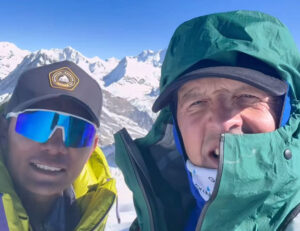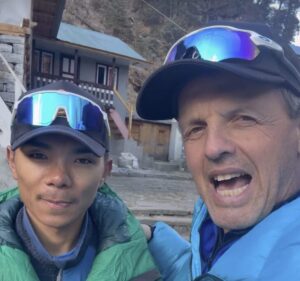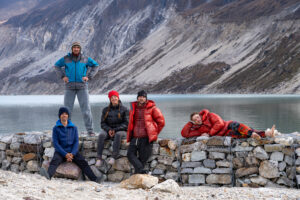On October 3, the 2022 Manaslu season apparently ended when all remaining teams called off their expeditions because of bad weather and avalanche danger. Twenty-four hours later, local outfitters announced that Grace Tseng of Taiwan and three Sherpa guides had summited the mountain. Tseng, they said, used no supplementary O2.
Two weeks later, so many people around the world have expressed doubts about her claims that the Taiwanese company in charge of her crowdfunding has stopped accepting donations on her behalf. No climber except for those affiliated with the companies she hired has publicly stood up for her. But why doubt her claim?
The reason is not the summit itself. While she climbed Manaslu in strange circumstances — no one else on the mountain, in highly dangerous conditions — that part of her climb is unmistakable: Dolma Outdoor shared a summit photo and a short video of it.
What prompted the doubts was the remarkable time that she claimed for her ascent: 13 hours from Base Camp to summit, in deep snow, with a good part of the trail unpacked, and ropes missing from the higher slopes.
“Grace Tseng has now become the fastest female to summit Manaslu without supplementary oxygen,” Dolma Outdoor announced. In fact, it was more than that. That time would be tied for the fastest ascent ever on Manaslu, with or without oxygen.
Francois Cazzanelli set the previous Manaslu speed record in 2019. Cazzanelli also took 13 hours to ascend without oxygen. In 2014, climber and skier Andrzej Bargiel needed 14 hours and 5 minutes to summit Manaslu from Base Camp, also without O2. He completed the round trip in 21 hours and 14 minutes, skiing most of the way down.
Both Cazzanelli and Bargiel are skimo racing champions — elite athletes and specialists in fast ascents. They are also expert climbers with a long history of not using supplementary O2. Cazzanelli smashed the previous speed record on Ama Dablam last year and ran up Nanga Parbat in 5 hours and 29 minutes, eventually finishing the total climb in just eight hours. Bargiel has climbed and skied down K2 and attempted a similar feat on Everest earlier this month. Grace Tseng has never made a speed climb before, not in the Himalaya or anywhere else.
Tseng’s background
Tseng’s first 8,000m experience was on Manaslu in 2019. She reached a part of the foresummit that was clearly not the highest point. As with several other climbers, this prompted her to return to the mountain this fall to make her summit indisputable.
After that initial Manaslu foray, she showed up on Kangchenjunga in the fall of 2020 with a strong Sherpa team that included Nima Gyalzen and Gelje Sherpa. There was just one other group on the mountain, who fixed part of the route before they gave up. Tseng, Gyalzen, and Gelje then launched a summit push on their own.
Next, Tseng said that she would try Winter K2 with a seven-Sherpa team from Dolma Outdoor, led by Nima Gyalzen. Neither Tseng nor any other client made the top, though 10 Sherpas did achieve that remarkable first winter ascent. Videos of her progress on the glacier revealed a lack of ice-climbing skills. This led to some comments from experienced climbers on social media.
After K2, Tseng ramped up her peak bagging, determined to beat out other young women in the quest for the 14×8,000’ers. She has summited everything she set foot on, always with Nima Gyalzen in the lead and other Sherpa guides.

Nima Gyalzen Sherpa has climbed with Tseng on all her 8,000’ers. Photo: Dolma Outdoor
At 29, Tseng cannot compete with Adriana Brownlee, 21, for the age record, or with Kristin Harila’s potential speed record. However, she intends to become the first Taiwanese woman to climb the 14×8,000’ers. During her last two climbs, she has also claimed other achievements.
This past summer on K2, after a long wait in Camp 4 and a very crowded summit push, she announced that she had summited without O2. Tseng was one of 145 climbers who topped out on that busy day.
Then she went to Manaslu. According to her Taiwanese compatriots, Tseng does not appear to have done any training for a high-altitude speed ascent. We asked three well-known Taiwanese climbers, all with 8,000m experience, about Taiwanese speed records. Chang Yuan-Chih, Lee Meiliand, and Fish Tri (who was also on Manaslu this season) had the same answer: They were unaware of any previous speed climbs by Tseng.
What we know about Tseng’s Manaslu climb
A small group waved Grace Tseng and Nima Gyalzen goodbye from Base Camp at 6:30 pm on October 3. From there, they were on their own until Camp 3. Here, Phurba Thiley Sherpa and Lakpa Tamang joined them until the summit. Dolma Outdoor shared a short video of one of the local guides stepping into hip-deep snow, possibly above Camp 3.
These are incredibly slow conditions, brutally hard to advance through, especially at altitude. However, the weather was good, much better than usual this season and slightly colder than the day before. The lower temperatures after warm days on October 1 and 2 could have stabilized the snow to a certain point.
“From Samagaon, it looked like a perfect summit day, all the more frustrating for those of us who had just gone down to the village,” Lorena Coroiu of Romania told ExplorersWeb.
Dolma Outdoor posted that summit picture and video on October 5 but has provided no further information. It is unclear when Tseng and her team returned to Base Camp.
Conditions on October 2-3
After three days with high winds, October 2 was expected to be a great summit day, with weaker winds and some sun. Over 50 climbers waited in Camp 3. But the forecasts were wrong. On October 1, at around 3 pm, it started snowing and didn’t stop all night. Climbers heading for Camp 4 stayed in Camp 3. Those coming down from Camp 4 after their summits got lost because of missing or buried ropes, Flor Cuenca told ExplorersWeb. Some were hit by small avalanches, luckily without major injuries.
Some Sherpas moved from Camp 3 to Camp 4 in the morning to supply more oxygen for those waiting higher up, but in the wind, drifting snow had filled in their packed-down trails.

Allie Pepper of Australia looks up at Manaslu’s summit on October 3 after returning to Base Camp. Fresh snow covered the mountain, but the weather itself was good. Photo: Alice Pepper
On the afternoon of October 2, a bigger avalanche killed Dawa Chhiring between Camp 2 and Camp 1. That discouraged most climbers. Allie Pepper from Australia, climbing with Seven Summit Treks, recounted the difficult decision.
The owners of Seven Summit Treks, brothers Dawa and Mingma Sherpa, were at Camp 3 with us on October 2. There were still a lot of climbers there. Some had decided to go down but wait for the next morning. Dawa and I decided to wait and see if we could do the summit in one push from Camp 3. We could not do this alone with new snow at waist height. As the sun was setting, boss Dawa made the call to cancel the summit push. We respected his decision, as did everyone else still at Camp 3. We slept one more night there, woke up to cold winds, packed up, and embarked on stressful journey down the mountain.
Those who had waited had a nerve-wracking descent on the morning of October 3. Lorena Coroiu, climbing with 8K Expeditions, described the route that morning.

Avalanches between Camp 4 and Camp 3 on Manaslu, October 3. Photo: Lorena Coroiu
There were no further avalanches between Camp 4 and Camp 3, only some snow sliding…but the avalanche risk was maximum and there were no ropes any more above Camp 3. The route was windswept and there were windslabs everywhere between Camp 3 and Camp 2. As I climbed that section, there were two fresh avalanches on the trail and many others close to the trail. Camp 2 was snowed under, the tents were hardly visible and many were broken.
Many people [paid for and] took the helicopter directly from Camp 2 because the route to Camp 1 was really dangerous. It was sunny and it started to warm up (around 10 am). Between Camp 2 and Camp 1 there were many avalanches that had fallen the previous night. Possibly it was not so risky anymore, but there was a lot of snow (we walked through the trail with 1m of snow). Camp 1 was buried too.
Coroiu estimated that there was avalanche debris on every section of the route over 50º.

Broken windslabs between Camp 3 and Camp 2 on Manaslu, October 3. Photo: Lorena Coroiu
Raised eyebrows
The mountaineering community holds climbers who make bold claims about speed or difficult routes to very high standards. Historically, this means providing summit photos, videos, eyewitness accounts, and other evidence to support history-making claims.
Tseng has not provided any proof of the remarkable time she claims. No witnesses can add to the story, since she climbed alone with her guides. All the other expeditions had called their attempts off and descended in quite risky conditions.
“In the conditions I saw on the mountain, I think it is hardly possible to complete the route in 13 hours,” said Lorena Coroiu, who had retreated to Base Camp.
Tseng’s summit push came as a surprise to everyone, but her speed most of all. There was one metre of fresh snow — murderous conditions for even a slow trudge with oxygen, let alone a speed record without oxygen. Ropes were also reported missing from Camp 3, and the trail was not packed down from Camp 4 to the summit.
Kristin Harila, Pasdawa Sherpa, and Dawa Ongchu Sherpa climbed in similar conditions on Manaslu (on September 22) and needed 19 hours just to get from Camp 3 to the summit with bottled oxygen. Tseng covered that distance in eight hours without O2.

Documenting her climb, Kristin Harila posted when she finally arrived back at Camp 3 on Manaslu. Photo: Kristin Harila
How had Tseng, who had struggled with her ice-climbing skills just months earlier, suddenly become an elite no-O2 speed climber? One man who had been on previous peaks with Tseng doubted that it was possible. He recalled that she depended heavily on her Sherpas and lacked climbing skills.
Knowing how to use crampons, clipping efficiently to ropes, and moving fluently up vertical sections increase safety, but they also shave off minutes. Over the hours, those minutes add up. Proficient climbing is essential for a speed record, especially when your competitors include the likes of Cazzanelli and Bargiel.
ExplorersWeb asked several climbers who were on Manaslu this season. They declined to comment on the record since they weren’t on the mountain at that time. But none supported her claim, either. Only a local outfitter added a positive word:
“Grace has already climbed and summited multiple 8,000m peaks, including K2 without O2. She is super strong,” Lakpa Sherpa, owner of 8K Expeditions, told ExplorersWeb. Lakpa, however, only saw Tseng leave Base Camp on October 3 at 6:30 pm. He could not speak to her time.
Asking questions
Tseng herself has not provided any details. Nor did she announce her intentions before leaving Base Camp, as climbers often do on social media. On October 2, the day before she left for the summit, she posted about the avalanche that hit Base Camp and noted that Manaslu was “not calm” that season. Since her summit, she has only shared a photo that someone in Base Camp had scribbled on a piece of paper, supposedly indicating her time at different checkpoints.
Dolma Outdoor has kindly shared that paper with ExplorersWeb:

Tseng’s timing from BC to summit, as noted from Base Camp. Photo shared with ExplorersWeb by Dolma Outdoors
We messaged Grace Tseng and Nima Gyalzen Sherpa for details. Two weeks later, neither has replied. Hungarian journalist Laszlo Pinter tried asking Tseng directly on her FaceBook page. She answered that the liaison officer in Base Camp had registered her times. Pinter replied as follows:
Criticism seems especially harsh in her homeland, where K2 summiter Zhang Yuanzhi has publicly doubted Grace Tseng’s previous no-O2 claim on K2. As we stated above, because of the questions around her accomplishments, the company handling her crowdfunding has stopped accepting donations on her behalf.
The Himalayan Database team in Kathmandu did not have a chance to speak to Tseng after Manaslu, because she flew directly to Cho Oyu’s south side. Eberhard Jurgalski and the 8000ers.com team are studying Tseng’s claims and will issue a statement soon.
The greater the achievement, the more details needed
It is natural to question achievements that are so remarkable that they seem at the very limits of human capability. Benjamine Vedrines recently achieved a mind-blowing time on Broad Peak: 7 hours and 28 minutes. His time was so fast that it also raised some questions.
But Vedrines had witnesses and plausible explanations. He climbed with other (very fast) partners until the final ridge. He also submitted his GPS track, gave plenty of detail in interviews, and revealed one of the keys to his success. Vedrines told Alpine Magazine that he had climbed Broad Peak just a few days before to familiarize himself with the route and the conditions. Meanwhile, Tseng had only climbed Manaslu in 2019 with O2. During that 8,000m climb, her first, she was totally dependent on her Sherpa team.
Conclusion?
There is a broader question about no-O2 climbs in general. It’s one thing when you climb for yourself. Then any style you’re comfortable with goes. But can you claim a no-O2 speed record, to be acknowledged by the whole mountaineering community, while supported by several Sherpas using O2?
They pack down the trail for you, carry most of your gear, and even bring a spare bottle of oxygen and a mask, in case you’re not feeling well. We’ve written about this “psychological oxygen” before. It not only relieves stress but affects decisions: Having O2 somewhere at hand is a very helpful option when you face the decision of whether to push ahead or retreat.
From a mountaineering point of view, Tseng’s record has limited value because she climbed so heavily supported. Yet other records in commercial mountaineering, such as the first summiter from a particular country or the youngest climber, also occur with heavy support. These can still lead to fame, social media followers, and funding. The merit of guided climbs may be relative, but the truth still matters, regardless of the methods used.
On October 3 and October 4, conditions suggest that a rapid ascent on Manaslu would have been extremely unlikely. Tseng’s Manaslu achievement is a big enough claim to require an explanation. The entire sport suffers when doubt seeps in. Tseng has a responsibility to provide a clear picture of her climb, and we look forward to her report.







